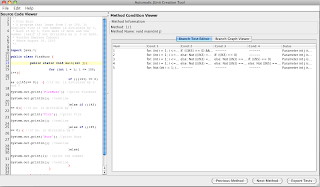Overview
The Automatic JUnit Creation Tool analyzes java classes to map all possible test branches. The tool has a wizard that guides users through the generation of a JUnit test. This tool is very helpful to programmers who's new to JUnit. It helps user to focus more on the test cases for their program rather than spending more time figuring out how to create a test program. This tool generates a JUnit code that can either save or copy and paste.
 |
Creating JUnit for FizzBuzz Program with JUnit Creator (version 1.25). The Generated JUnit code for Fizz Buzz Program |
Primitive Directive 1
This program is very simple yet very useful and helpful. It eliminates the needs for writing a test program from scratch, which come in handy for busy programmers. The wizard covers all options that you may want to include in your test program.
The user interface is simple, with your program on left side and the conditions and execution paths on the right.
 |
| Automatic JUnit Creator (version 1.26). |
Primitive Directive 2
The size of the program is 7.5 mb, which make it easy to download and is available for multiple platforms such as Windows, Mac OSX, Linux and other. The package includes the library, readme and sample programs that can be use to demo the software. It requires no other configuration on the user’s computer. It can be either run by clicking the .jar file or through the terminal.
There are two version of the program- 1.25 and 1.26. The version 1.26’s user interface is simpler with less buttons to click, but it lacks the documentation. The 1.25’s documentation is well written with step-by-step instructions and graphics in PDF format.
Primitive Directive 3
The developer-level documentation is available in the software’s homepage. It includes the design overview that shows the packages and technologies it uses and includes the link for other information and sources about the program.
The author includes an instruction on how to setup the Development Environment, which uses Netbeans. The author also allows others to contribute and write into the software’s repository granted with his permission.

No comments:
Post a Comment